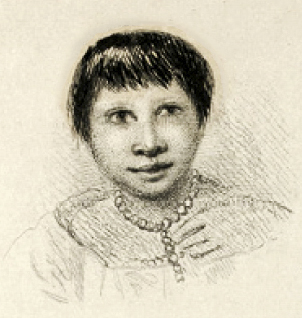Yokcushlu was one of the Alakaluf, or canoe people from the western part of Tierra del Fuego. She was one of the hostages seized by Robert FitzRoy, captain of HMS Beagle, after the small boat used for surveying the narrow inlets of the coast of Tierra del Fuego had been stolen in 1830. FitzRoy intended to release his captives on return of the boat, but all the hostages managed to escape except for three children. FitzRoy kept only nine-year-old Yokcushlu hostage because she seemed so happy and healthy, and he wished to teach her English. She was popular on board the Beagle, and became more content after FitzRoy took a man from the Alakaluf tribe called Elleparu, whom he renamed York Minster. Yokcushlu was named Fuegia Basket by the men who had to build a make shift coracle-like basket to return to the Beagle following the theft of their boat.
After FitzRoy captured two more men (Boat Memory and Orundellico), he decided to bring his four captives back to England, educate them, instruct them in religion, and return them to Tierra del Fuego to act as moral exemplars to their own people and interpreters for passing English ships. On the voyage to England, the captives were vaccinated against smallpox in Monte Video, where Yokcushlu stayed with an English family while the men remained with FitzRoy. After being overcome with terror at the sight of a steamship in Falmouth harbour, Yokcushlu's earliest experiences of England were the smallpox ward of the Plymouth Naval Hospital, the death of Boat Memory, and being exposed to measles in order to gain immunity. She, together with Elleparu and Orundellico, then began her education with a schoolmaster and his wife in Walthamstow.
Over the following months, Yokcushlu, together with Elleparu and Orundellico, met a select group of people, including FitzRoy's relations, men of science, and even King William. Queen Adelaide was particularly taken with Yokcushlu, and gave her a bonnet, a ring, and some money. FitzRoy did not treat his captives as scientific specimens or freaks, although he did subject them to a phrenological examination. This revealed that Yokcushlu was the one most likely to become a useful member of society in a short time as she readily received instruction. By the summer of 1831, FitzRoy had spent £1,500 of his own funds on keeping and educating the three natives from Tierra del Fuego, and felt it was time they were returned to their home. Yokcushlu left England in the Beagle on 27 December 1831.
During the voyage, Yokcushlu was betrothed to Elleparu even though she appeared to like Orundellico better. Darwin thought Yokcushlu a modest girl of quick learning, especially her capacity for learning languages. During a landfall of three months in Rio de Janiero, Yokcushlu lived with an expatriate family, teaching their children English while she learned how to converse in Portuguese. In Monte Video, she learned Spanish. The education and clothing she, Elleparu, and Orundellico had received in England may have heightened Darwin's shocked reaction to his first sight of their 'savage' compatriots in their native state. Bad weather prevented FitzRoy from reaching Yokcushlu and Elleparu's part of the country, so he left them in Orundellico's region, together with the missionary Richard Matthews, who had been sent by the Church Missionary Society to accompany the returning Fuegians to set up a mission. Within days, however, FitzRoy had removed Matthews, believing it to be too dangerous for him to remain in Tierra del Fuego.
When Yokcushlu and Elleparu decided to move west to their own land following an attack, they persuaded Orundellico to go with them. En route, they met a party of Alakalufs, including Elleparu's brother, who, aided by Yokcushlu, stole Orundellico's clothes and goods before abandoning him. On reaching her home territory, Yokcushlu lived with Elleparu until he was killed in retaliation for murdering a man. She was sighted by various passing ships in the 1840s, and recognised by her greeting, 'How do? I have been to Plymouth and London'. On hearing a report of one such encounter with a sealing ship, Darwin expressed his concern. 'Without a doubt this was Fuegia Basket. She lived (and I fear the term probably bears a double interpretation) some days on board' (Darwin 1845, p. 228 n.). Joseph Dalton Hooker told Darwin that after reading this, he 'went to bed quite melancholy at the fate of poor Fuegia Basket'. This news about Yokcushlu was also shared with Simms Covington in 1853.
Yokcushlu was next heard of in 1873, when she visited the Ushuaia Mission in the Beagle Channel for several days. Despite having lost much of her English, she told the missionary Thomas Bridges about the circumstances of Elleparu's death, as well as recalling her time on the Beagle and in London. She was accompanied by a young man who was her husband. Bridges hoped that Yokcushlu would live at the mission, but she wished to return to her two children by Elleparu. When Bridges went into the western region of Tierra del Fuego in 1883, he found Yokcushlu, frail and unhappy, nearing the end of her life.
References:
Chapman, Anne. 2010. European encounters with the Yamana people of Cape Horn, before and after Darwin. Cambridge: Cambridge University Press.
Hazlewood, Nick. 2000. Savage. The life and times of Jemmy Button. London: Hodder and Stoughton.
Darwin, C. R. 1845. Journal of researches into the natural history and geology of the countries visited during the voyage of H.M.S. Beagle round the world, under the Command of Capt. Fitz Roy, R.N. 2d edition. London: John Murray.
Narrative: Narrative of the surveying voyages of His Majesty's ships Adventure and Beagle, between the years 1826 and 1836. [Edited by Robert FitzRoy.] 3 vols. and appendix. London: Henry Colburn. 1839.
ODNB article: https://doi.org/10.1093/ref:odnb/72137



